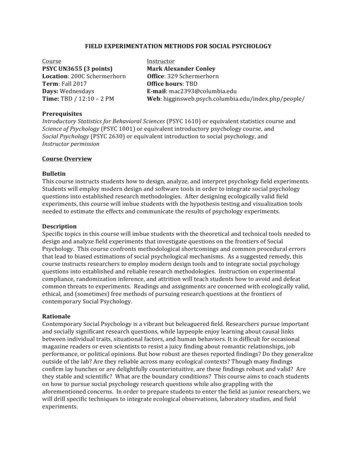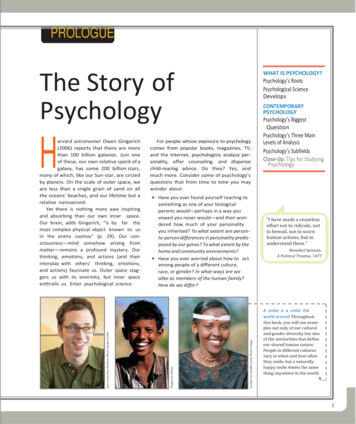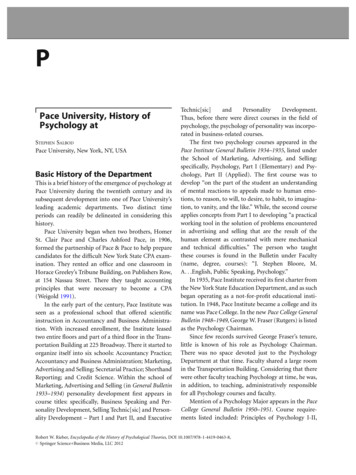
Transcription
Social Psychology (PSY403)VUSocial Psychology (PSY403)Table of ContentsLesson 1Lesson 2Lesson 3Lesson 4Lesson 5Lesson 6Lesson 7Lesson 8Lesson 9Lesson 10Lesson 11Lesson 12Lesson 13Lesson 14Lesson 15Lesson 16Lesson 17Lesson 18Lesson 19Lesson 20Lesson 21Lesson 22Lesson 23Lesson 24Lesson 25Lesson 26Lesson 27Lesson 28Lesson 29Lesson 30Lesson 31Lesson 32Lesson 33Lesson 34Lesson 35Lesson 36Lesson 37Lesson 38Lesson 39Lesson 40Lesson 41Lesson 42Lesson 43Lesson 44Lesson 45Introduction To Social PsychologyIntroduction To Social Psychology (Continue)Conducting Research In Social PsychologyConducting Research In Social PsychologyConducting Research In Social PsychologyConducting Research In Social PsychologyConducting Research In Social PsychologyConducting Research In Social PsychologyThe SelfThe SelfThe SelfThe SelfPerson PerceptionPerson PerceptionPerson PerceptionAttributionAttribution ErrorsSocial CognitionSocial CognitionAttitudesAttitude FormationAttitude And BehaviorAttitude ChangeAttitude ChangePrejudice And DiscriminationPrejudice And DiscriminationReducing Prejudice And DiscriminationInterpersonal AttractionInterpersonal AttractionIntimate RelationshipsSocial InfluenceSocial InfluenceSocial InfluenceAggressionAggressionReducing AggressionProsocial BehaviorProsocial BehaviorGroup BehaviorGroup BehaviorGroup BehaviorInterpersonal Power: LeadershipSocial Psychology Applied: Social Psychology In CourtSocial Psychology Applied: Social Psychology In ClinicFinal 4169176180187
Social Psychology (PSY403)VULesson 01INTRODUCTION TO SOCIAL PSYCHOLOGYAimsIntroduction of social psychology is a very important discipline of psychology.Objectives1. Defining social psychology.2. Introduce main content and subject matter of social psychology in relations to differentquestions of interest in this discipline.General Introduction of the CourseSocial psychology is the scientific study of how people think, influence, and relate to one another.It is a comparatively young discipline. The broad theme of this course will be how individuals’thoughts, feelings, and behaviors are influenced by other people -- the SOCIAL influences. SocialPsychology is a surprisingly broad field that overlaps with other sub-disciplines of psychology likepersonality and cognition, and various other human disciplines like anthropology, sociology, andcommunication.Learning Objectives of this course To acquaint the students with the field of social psychology. When we say “the field ofpsychology, we mean a broad range of topics relevant to social psychology, generalscientific approach of the discipline, and various concepts, principles, and theoriespertaining to this discipline. To provide many insights into our own and others’ behavior. Benefiting one’s own relationships and services as a friend, relative, roommate,neighbour, and co-workerPractical application of this courseThrough journal writing and Applied social psychology Lab students will be able to experience thepersonal relevance of social psychology. The introduction of these two procedures is as under:Journal: One means of enhancing the course’s personal relevance is an assignment called a“Journal”, which students will accomplish as the course will proceed.Applied Social Psychology Lab: Different classroom activities will be conducted to givestudents a practical overview and knowledge about the application of Social Psychology by casereports, small activities, and current researchBy the End of this course students will be able to:Demonstrate foundational knowledge in social psychologyApply social psychological phenomena to one's own thinking, behavior, and relationshipsRecognize the extent to which social behaviors are influenced by situational and interpretivefactorsReadingsText BooksFranzoi, S.L. (2006). Social Psychology. New York: McGraw Hill.David G. Myers, D. G. (2003). Social Psychology (7th ed.). New York: McGraw-Hill.Other ReadingsLord, C.G. (1997). Social Psychology. Orlando: Harcourt Brace and Company.Lippa, R.A. (1994). Introduction to Social Psychology. Belmont: Brooks/Cole PublishingCompany.What is Social Psychology?@Copyright Virtual University of Pakistan1
Social Psychology (PSY403)VUIn the following two definitions of social psychology have been described, the first of these hasbeen quoted in majority of the textbooks on social psychology.Social psychology is a discipline that uses scientific methods in “an attempt to understand andexplain how the thought, feeling and behaviour of individuals are influenced by the actual,imagined or implied presence of others” (Gordon Allport, 1985, p. 3).Social psychology is the scientific study of how individuals think. Feel, and behave towardother people and how individual’s thoughts, feelings, & behaviours are affected by other people(Brehm, Kassin, & Fein, 2002, p. 5).Main Elements of DefinitionsThoughts, Feelings, and Behaviours of individualInfluence of other peopleHow these influences will be studied? It will be done by the use of Scientific Method.The definitions suggest a cause and effect equation – people influencing individual’s thoughts,feelings and behaviour.Main Questions of Interest in Social PsychologyThe topics of social psychology—attitudes, person perception, interpersonal attraction,conformity, etc. are among the most personal but largely unexamined parts of ourselves.Questions of interest in social psychology can be divided into 3 categories: these 3 categoriescorrespond to thoughts, feelings and behaviour components of definition of social psy. However,this is merely a convenient way of organization, one overlaps with other part.The main questions/ topics of interest in social psychology are as given below:Thinking about the self and othersEvaluating persons and relationshipsInteracting with othersIst Question: Thinking about the self & othersEach question of interest can be further divided into different categories. For example, differentquestions can be asked under this first question of interest. The following 4 questions seemdiverse but they refer to the thought process.Social cognition is thought process in general; however, other questions given below investigateone specific kind of thinking.Social cognition: Researchers who are working on social cognition can ask the followingquestion in their investigation: “How do jury decide guilt or innocence”Person perception: People working on person perception can be curious to know: “How do weknow when someone is lying or telling truth”Attribution: It refers to thought process that occur when we decide what caused anotherperson’s behaviorThe self: We ask specific questions about ourselves, for example one may be inquisitive that“when does a thin body image promotes eating disorders”2nd Question: Evaluating people & relationshipsThe following 5 questions also seem diverse but they all involve people’s feelings. Attitude is themost basic type of field - about feeling in general.Attitude: feelings lie at the core of and neg. attitudes; how feelings, thoughts and behaviourrelate to each other: why people feel one way and yet behave in exactly the opposite wayAttitude change: This question of social psychology is concerned with when and why peoplealter their attitude over time. For example, “how can we instill positive attitude in children towardschool”.Prejudice: People interested in research on prejudice, etc. may also be interested in investigatingthat “how can society reduce stereotyping and discrimination”Interpersonal attractions: These issues may question, “why do people desire to make friendswith one and not the others”, or “why people feel romantic attraction for one and not for otherperson”.@Copyright Virtual University of Pakistan2
Social Psychology (PSY403)VUClose relationships: Researchers working in this area may be inquisitive that “how our feelingstoward significant others change over time”, for example, how happy marriages end into bitterdivorces.3rd Question: Interacting with OthersHuman beings interact through many different behaviors; some of them are given below:Social Influence: studies how one person’s behaviour/ presence influences another person’sbehaviour.Helping: “How can we convince more people to help disabled”Aggression: “Does media violence promotes violence in real life” why people assault, hit, andkill each otherInterpersonal Power: why ordinary citizens sometime engage in torture, ethnic cleansing, orgenocideGroups: “Why can’t one religious group agree with the other”. whether people behavedifferently while in group.The above mentioned 14 questions, which correspond to three main questions of interest asindicated in the definition of psychology, have been the content of majority of the text books onsocial psychology in the form of different chapters of the text. This suggests that the subjectmatter of social psychology is different components of thoughts, feelings, and behaviors ofindividuals.How Others’ Presence Affect an individual?The definition of social psychology suggests that it is the scientific study of how individual’sthoughts, feelings, and behaviours are influenced by the actual, imagined or implied presence ofother people. To better understand this definition, let’s take a few examples.Actual Presence of people affecting the individual:First take an example, how might the actual presence of others influence one’s thoughts, feelingsand behaviour. Response of cricket players may become different when fans of some opposingteam shout and make loud noises to divert attention of the players. Similarly, your behaviour willbe changed if you notice that someone is watching you.Imagined Presence of people affecting the individual:Regarding how the imagined presence of others might influence thoughts, feelings, and behaviour,think about past incidents when you were considering doing something that ran counter to yourparents’ wishes. Although they may not have been actually present, did their imagined presenceinfluence your behaviour? For example, if your parents have prohibited you from smoking, andyou start smoking in a party on peer pressure, does their imagined presence affect your behaviour?Imagined presence in certain cases can be quite strong, as indicated by Shaw (2003), “Imaginedfigures can guide our actions by shaping our interpretation of events just as surely as do those whoare physically present”. In a few conditions, imagined presence can also help us fight negativeemotions. For example, McGowan (2002) pointed out that in anxiety imagined presence of otherscan serve as emotional security blanket. Similarly, daughter of one renowned social psychologistconfided to her father that she wants to be as brave as two young wizards, Harmione & Harry inHarry Potter books.Implied Presence of people affecting the individual:Finally, how the implied presences of others influence an individual? If you have an experience ofdriving on the motorway, you would have noticed that signs of specific speed limit make youconscious. Similarly, in shopping stores sometime posters indicate that “You are being watched”.All of this makes you self ware and brings a change in your behaviour.Other Factors affecting the individual@Copyright Virtual University of Pakistan3
Social Psychology (PSY403)VUSocial psychologists also believe that it is not only the presence of other people that influences aperson’s thoughts, feelings and behaviour, but some other factors are also contributing to that. Inthis reference, three kinds of explanations of social behaviour can be presented. Figure1.1 presentsthe factors that a social scientist might use to explain human behaviour.This diagram shows that three explanations can affect human social behaviour infollowing ways:Broad group level explanations, i.e., evolutionary and cultural factorsIndividual-level explanations: such as childhood experiences, and family historyMediating variables: internal factors such as personality traits, and attitudes.Broad Group-level Explanations: Evolutionary and Cultural FactorsAnimals show different pattern of aggression than human beings, These are biological based. e.g.,organized warfare seems to be a uniquely human activity. Similarly, people living in differentcountries demonstrate differences in exhibition of aggression. Evolutionary factors indicate thatpeople living at particular places/ locations have evolved with a tendency to become more or lessaggressive to outsiders than to their own kind? For example, tension and resulting aggression inYugoslavia and other countries like Israel and Palestine could be due to evolutionary and culturalfactors both. To explain cultural differences in aggressive behaviour, Margaret Mead (1935)reported that some societies are peaceful (e.g., Arapesh of New Guinea) while others, althoughliving in the same geographical region) are dominating and aggressive (e.g., Mundugumor of newGuinea)Differences have also been reported in world-wide Violence rates, for example, in 1980s, violencerates of 8.5%/100,1000 were reported in the USA as compared to 1.9% in Canada, and 0.6% inthe UK. These different statistics indicate effects of culture and evolutionary factors on socialbehaviour.Individual-level ExplanationsHeredity & physiology: Genetic and biological factors also influence human social behaviour.For example, males have been found more aggressive than women due to a male hormone@Copyright Virtual University of Pakistan4
Social Psychology (PSY403)VUtestosterone (Eagly & Steffan, 1986). Morevover, men with higher levels of testosterone havebeen reported as more aggressive than those with lower levels (Dabbs & Morris, 1990).Past experiences: Early learning and child rearing practices also contribute to differences inpeople’s social behaviour. For example, girls are taught not to be aggressive by their parents fromtheir childhood. Moreover, expression of anger is not appreciated in girls and women. This genderdifference is also very pronounced in some cultures, so culture also plays a dominant role in theseassociations. This also suggests that these group or individual level explanations are not mutuallyexclusive; they all seem to interact with each other. Another example can be how aggressionwould have been created and shaped in Kashmiris and Palestinians by the teachings of theirparents in the process of growing up.Current situational factors could also influence a person’s behaviour. The classic study ofHoveland and Sears (1940) could be illustrative in this case. They found a significant correlationbetween economic frustration and lynching of black by white people in Old South. Media violenceis an ever-present influence as far as situational factors are concerned. Another example isconformity research, where results showed that how group pressure can induce people shift theirbeliefsMediating VariablesMediating variables create a link between situational, cultural, and individual level explanations.These are related with the person concerned and can not be directly observed, so they must beinferred from a person’s behavior. The effect of mediating variables indicate that forunderstanding a person’s thoughts, feelings and behaviour, one must slip inside the skin of theindividual. The following refer to different mediating variables:Beliefs: compromise the cognitive information.Attitudes are evaluative responses.Schemas: a kind of mental model that people holdEmotions: transient states of arousal that direct our behaviorPersonality traits are stable dispositions influencing broad domains of behaviorCurrent Responses of the individualFigure 1.1 indicates that all of these evolutionary, cultural, individual, situational, and mediatingvariables determine a person’s social thoughts, feelings and behaviour.Readings1. Franzoi, S.L. (2006). Social Psychology. New York: McGraw Hill. Chapter 1.2. Lord, C.G. (1997). Social Psychology. Orlando: Harcourt Brace and Company. ChapterLippa, R.A. (1994). Introduction to Social Psychology. Belmont: Brooks/ColePublishing Company. Chapter 1.@Copyright Virtual University of Pakistan5
Social Psychology (PSY403)VULesson 02INTRODUCTION TO SOCIAL PSYCHOLOGYAims:Introducing link of social psychology with other disciplines and tracing the historical roots.Objectives:1. Understanding whether social psychological research outcomes are just what wecommonly believe.2. Understanding the relation of social psychology with other disciplines.3. To understand social psychology as a profession.4. Understanding the major theoretical roots of social psychology.Is Social Psychology simply Common Sense?A common refrain voiced by laypeople and scientists is that most, if not all, of behavioral science“is just common sense.” Social psychology students are particularly likely to make this claim,given that much of their prior exposure to social psychology probably has taken the form ofaphorisms such as “opposites attract,” “absence makes the heart grow fonder,” or “two heads arebetter than one.” In a nutshell, it’s difficult to counter the “common-sense” stigma when somuch of behavior seems to be explainable at an intuitive surface level.People think of social psychology as simply rephrasing what we already know because its subjectmatter is so personal and familiar. This is referred to “as if I knew it all along” phenomena. Weinformally think about our feelings, thoughts and actions. Why this informal thinking will bedifferent from what social psychologists achieve through scientific observation? In many waysthis is true. Let’s look at these examples, they confirm what many of us already know. “Attending to people’s face leads to the greatest success in detecting their lies” “People are less likely to blame accident victims if they are similar to them” “People who are paid a great deal of money to perform a boring task enjoy it more thanthose who are paid very little” “Men express more hostile attitude toward women than women do toward men” “People think that physically attractive people are less intelligent than those who arephysically unattractive” “Playing violent video games or engaging in contact sports allows people to “blow offsteam” making them less aggressive” “Accident victims are most likely to be helped when there are many bystanders nearby”Interestingly, all of these make sense, but they have been proven wrong by social experiments.Actually events are far more “obvious” and predictable in hindsight than beforehand. Many atime social psychology confirms our common sense notions but there are many instances whenthe scientific findings challenge our current social beliefs. The problem with common sense isthat we invoke it after we know the factsExperiments reveal that when people learn the outcome of an experiment, the outcome suddenlyseems unsurprising.Activity to demonstrate social psychology as simply commonsense:You can do a small activity to further understand this commonsense phenomenon. Give half agroup one psychological finding, and the other half the opposite (as given below).Psychological Finding 1:“Psychologists have found that when it comes to making friends, or falling in love, we are mostattracted to people whose traits are different from our own. There seems to be wisdom in the oldsaying that “Opposites attract”Psychological Finding 2:@Copyright Virtual University of Pakistan6
Social Psychology (PSY403)VU“Psychologists have found that when it comes to making friends, or falling in love, we are mostattracted to people whose traits are similar to ur own. There seems to be wisdom in the oldsaying that “Birds of a feather flock together”Then you ask both groups whether results surprised them, and you will find that both groups willfind the results not at all surprising. In fact, many will state that they already thought the same.Social Psychology and Related FieldsSocial psychologists are keenly interested in how people think about, influence, and relate to oneanother. But so are sociologists and personality psychologists. The question is how does socialpsychologist differ?Social Psychology and Sociology:Edward Jones (1998) indicates in Handbook of Social Psychology that two scientific disciplinesknown as social psychology are employed in both, one in psychology, and the other in sociology.He suggests that the larger of the two is psychological branch: psychological social psychology,and sociological social psychology.Social psychology focuses on the influence of people on the individual, whereasSociology downplays the role of individual and focuses on societal variables like socio-economicstatus (SES), people’s social roles, cultural norms, etc. On the other hand, social psychologyconcentrates on individual traits (personality traits and temperament) and processes that occur atindividual levelAlthough there have been calls to merge the two branches into a single field, and a jointpsychology-sociology doctorate program at the university of Michigan from 1946 to 1967- theirdifferent orientation made it doubtful. Despite the fact that an interdisciplinary social psychologymay never materialize, the two fields influence each other. The recent interest of socialpsychology is on the impact of culture on social behavior, while sociological social psychology’sis becoming increasingly interested in individual differences. Regardless of the crosspollinationthat has occurred over the years, both disciplines will continue to provide important yet differingperspectives on social behavior.Areas of interest in both disciplines:Sociologists might study trends in marriage, divorce, etc., while social psychologist mightexamine how certain individuals become attracted to one another. Similarly, sociologist studieshow racial attitude of high-class people as a group differ from that of low-class, socialpsychologist will be interested how racial attitude develops within the individual.The following table illustrates differences in both disciplines:PSYCHOLOGICAL SOCIAL PSYSOCIOLOGICAL SOCIAL PSY1. Central focus on individual1. Focus on group/society2. Variations in behavior believedto be due to people’sinterpretation of social stimuliand differences in personality.2. Explanations for such societalbased problems as poverty,crime, and deviance.3. Experimentationastheprimary research method,followed by correlationalstudies, and then observation.3. Observationalandthecorrelational studies as theprimary method, followed byExperimentationSocial Psychology and Personality PsychologyThese both disciplines can be considered as allies as their focus is on individual.@Copyright Virtual University of Pakistan7
Social Psychology (PSY403)VUMay be for this reason, American Psychological Association has included both disciplines in samejournals: Personality and Social Psychology Bulletin, and Journal ofHowever, both disciplines are also different from each other on a few dimensions. For example,personality psychologists are interested in individual differences, while social psychologists focuson common humanity and in knowing that how people view and affect one another. Anillustrative example for the difference in both disciplines is that Personality psychologist may beinterested in that why some individuals are more aggressive than other, whereas a socialpsychologist may be interested in knowing that how social situations can lead most individuals toact kindly, cruelly, to conform. Another difference is that as compared to personality psychology,social psychology has a brief history. Many famous theorists worked in the first half of 20thcentury, like Freud, Jung, Adler, Horney and Rogers.Social Psychology and BiologyMajority of the scientists agree that nature and nurture together form us. As area of a field isdetermined by its length and width, so do biology and experience together create us. There is nodoubt that our inherited human nature predisposes us to behave in ways that helped ourancestors survive and reproduce. Nature also endows us with an enormous capacity to learn.However, social neuroscientists do not regard complex behaviour like helping and hurting to justneural or molecular mechanism. They hence indicate that to understand complex behaviour wemust consider under-the-skin and between-skins influencesThe Profession of Social PsychologyPhD Social psychologistsMajority of PhD level social psychologists (75%) are working in Colleges / universities, while aminority (17%) works in Business/government setting. The pie chart given below shows thismore clearly.Colleges/universitiesBusinessOtherM.Sc Social psychologists enjoy job diversityThe work distribution of M.A. level social psychologists is as under:12% 4-year colleges44% other non university academic settings20% business/ govt.24% human service fields (clinics, health agencies, etc.)The following pie chart illustrates the same figures.@Copyright Virtual University of Pakistan8
Social Psychology (PSY403)VUBusinessCollegesHuman servicesOther educational settingsCurrent Trends:Currently, social psychologists are involved in different kinds of works, e.g., researching in healthpsychology, environmental psychology, legal system, and investigating social factors in clinicalpsychology. In Pakistan, however, the role of social psychologist is not that diverse and mainlythey are working in universities, and NGOs.Applying Social PsychologySocial psychology had always intimate ties to the larger political and cultural spheres. It hasaddressed important social problems in past and present. It has always focused on real lifeproblems, e.g., does media violence contribute to aggression in society; how social factors likefamily support can influence our susceptibility to disease, etc. The following examples show howsocial psychology has responded to current social problems of the time: World war II stimulated research on prejudice/conformity 1940-50s Civil war in US initiated work on prejudice/ stereotypes Higher violence/ crime rates in 1960-70s led to research on aggression. In 1980-1990s skyrocketing health care costs and growing awareness of behaviorscontributing to disease led to research social factors in health. 9/11 event led to research on terrorism/ suicide bombing. October 8 2005 earthquake in Pakistan initiated research on social and psychologicaleffects of disasters, and PTSD.These examples illustrate that how with the changing trends and circumstances in society,research also changed its focus.History of Social PsychologySocial psychology is a relatively young discipline. Although some work on it started at the end of19th century, most of the growth in social psychology occurred after 1950s. The history of socialpsychology reveals its American roots. The following periods illustrate the history of socialpsychology:The early years (1884-1934)The coming of age (1935-1945)Rapid expansions (1946-1969)Crisis and re-assessment (1970-1984)An expanded global view (1985-present)The Early Years: (1884-1934)Norman Triplett at Indiana University can be considered the first empirical social scientist as heconducted the first social psychological experiment on that how the performance of a persondoes change when other people are present. He noticed that a bicycle racer’s speed was fasterwhen he was paced by other cyclists than when he was alone. Based on this observation, hedevised the first exp. To learn what caused these different racing times, he asked children to wind@Copyright Virtual University of Pakistan9
Social Psychology (PSY403)VUline on a finishing reel both in the presence of other children and alone. The results showed thatchildren did faster when with other children. This experiment was published in 1897. Thisintroduced the Experimental Method in social psychology. However, the credit to establish socialpsychology as a distinct discipline goes to William McDougall (an English) and Edward Ross (anAmerican), who published the first books bearing this title. Although these two published bookson social psychology, Social psychology still lacked a distinct identity. Moreover, there was noanswer to the question that how does social psychology differ from other disciplines, and whatare its methods of inquiry, etc.Floyd Allport was the person who served this purpose. He wrote a third book on socialpsychology and indicated very clearly “I believe that only within the individual can we find thebehavior mechanisms and consciousness which are fundamental in the interactions betweenindividuals. There is no psychology of groups which is not essentially and entirely a psychologyof individuals. psychology in all its branches is a science of the individual” (1924, p.4). Heconducted studies on conformity, nonverbal communications, and social facilitation anddemonstrated in his book that how carefully conducted research could provide insight into awide range of social behaviors.The Coming of Age: 1935-1945First 3 decades of this century were spent in generating basic concepts and sound researchmethods in social psychology. Then two events occurred which played a dominant role in thedevelopment of social psychology at this critical juncture (World War II) in its history:1. Great depression in the USA2. Social and political upheaval in EuropeFollowing the stock market crash in 1929, many young psychologists were unable to find or holdjobs. Due to social forces, many adopted the liberal ideals of Roosevelt, or more radical views ofcommunist or socialist parties. In 1936, these social psychologists established Society for thePsychological Study of Social Issues (SPSSI). They wanted to apply their newly developedtheories and political activism to real-world problems.The rise of fascism in Germany, Spain, and Italy created a strong anti-intellectual atmosphere inmany of Europe’s educational institutions. As a result, many leading social psychologists like FritzHeider, Kur
Lesson 44 Social Psychology Applied: Social Psychology In Clinic 180 Lesson 45 Final Review 187 . Social Psychology (PSY403) VU . have been the content of majority of the text books on social psychology in the form of different chapters of the text. This suggests that the subject matter of social ps










